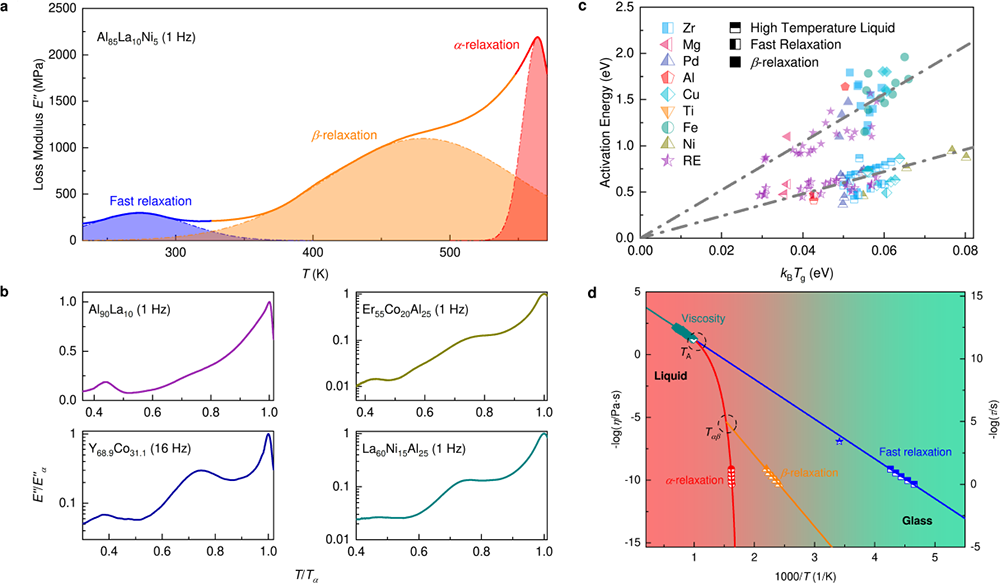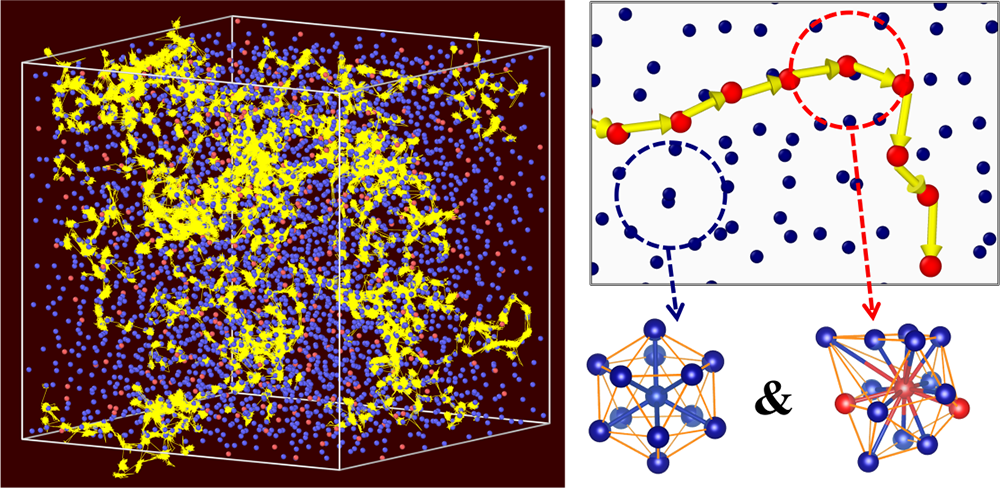Scientists Identify Liquid-like Atoms in Densely Packed Solid Glasses
Metallic glass is an important advanced alloy, holding promise for broad engineering applications. It appears as a solid form in many aspects, with beautiful metal appearance, exceeding elasticity, high strength, and a densely packed atomic structure.
However, this all-solid notion has now been challenged. Prof. BAI Haiyang from the Institute of Physics of the Chinese Academy of Sciences (CAS) has recently shown the existence of liquid-like atoms in metallic glasses. These atoms inherit the dynamics of high-temperature liquid atoms, revealing the nature of metallic glasses as part-solid and part-liquid.
Results were published in Nature Materials.
Condensed matter can generally be classified into solid and liquid states. Under extreme conditions or in specific systems, matter exists in special states that simultaneously exhibit some properties of both solids and liquids. In this case, solids may contain rapidly diffusing, liquid-like atoms that can move fast even at low temperatures.
For example, ice enters a "superionic" state under high pressure at high temperatures. In this state, H atoms can diffuse freely while O atoms are fixed in their sublattices. Such special states are also observed in Earth’s inner core and in the Li-conducting materials of advanced batteries, which are drawing growing attention in science and engineering.
In this study, the researchers revealed that liquid-like atoms exist in densely packed metallic glasses. Combining extensive dynamical experiments and computer simulations, they found that when the viscosity of a liquid deviates from Arrhenius behavior, not all atoms take part in cooperative flow and subsequent solidification. In fact, some atoms can maintain liquid Arrhenius behavior even when the system is cooled down to a glass state, thus appearing as persistent liquid-like atoms that lead to fast relaxation at rather low temperatures.
"A glassy solid is essentially mostly solid and a small part liquid. Even at room temperature, liquid-like atoms in a glassy solid can diffuse just as easily as in its liquid state, with an experimentally determined viscosity as low as 107 Pa·s, while the viscosity of the solid part is larger than 1013 Pa·s," said Prof. BAI.
These findings provide a clearer microscopic picture of glasses. This new picture can help scientists better understand how the properties of glass materials are related to their dynamics. For example, liquid-like atoms control the anelasticity of glasses and may affect their ductility.
Moreover, the strong relationship between liquid-like atoms and disordered structure also has implications for studying the topological origin of fast diffusion in solids, such as superionic-state matters and ion conductors.
This study was supported by the National Science Foundation of China, the Natural Science Foundation of Guangdong Province, and the Strategic Priority Research Program of CAS, among others.

Fig.1 Revealing liquid-like atoms in metallic glasses via dynamics experiments. (Image by Institute of Physics)

Fig.2 Visualization of Liquid-like atoms in Al90La10 MG at 300K by MD simulations. (Image by Institute of Physics)
Contact:
Institute of Physics
BAI Haiyang
Email:hybai@iphy.ac.cn
Key words:
Liquid-like atoms; relaxation dynamics; metallic glass;
Abstract:
Revealing the microscopic structural and dynamic pictures of glasses is a long-standing challenge for scientists. Tremendous studies about the structure and relaxation dynamics of glasses have constructed the current classical picture: Glasses consist of some "soft zones" of loosely-bound atoms embedded in a tightly-bound atomic matrix. Although recent experiments found an additional fast process on the relaxation spectra, the underlying physics remains unclear. Here, combining extensive dynamical experiments and computer simulations, we reveal that the fast relaxation is associated with string-like diffusion of liquid-like atoms, which are inherited from the high-temperature liquids. Even at room temperature, some atoms in dense-packed metallic glasses can diffuse just as easily as they would in liquid states, with an experimentally determined viscosity as low as 107 Pa·s. This finding extends our current microscopic picture of glass solids and might help establish the dynamic-property relationship of glasses.
